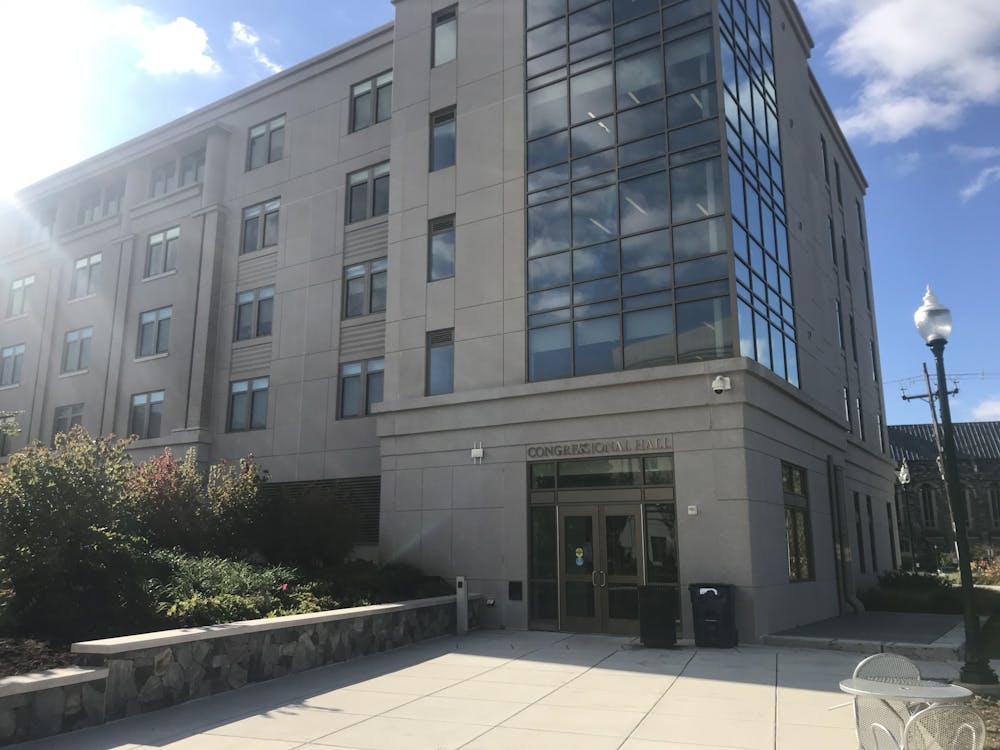Last semester, AUx launched its first Black affinity section for AUx2 after students spearheaded the effort and called for the creation of more safe spaces for Black students.
AUx2 is a course that all first-year students are required to take that examines race and racism — primarily anti-Blackness — and how it is manifested in socially constructed systems of power. The course also covers the intersectionality of race with other forms of oppression, as well as conversations on privilege and levels of access.
Like AUx1, AUx2 has peer facilitators in each class who assist the instructors in teaching the material. In the spring and summer of 2020, a group of Black peer facilitators began advocating for a Black affinity AUx2 section and were instrumental in its implementation, providing their input at monthly meetings and working closely with Izzi Stern, the AUx program manager, and Shaina Spann, a coordinator for the Office of the Provost.
Zoë Washington, a rising senior in the Kogod School of Business, was one of the AUx peer facilitators who called for a Black affinity AUx2 program.
“Myself and other peer facilitators, especially Black peer facilitators and Black students, saw a need for a safe space for Black first-year students and transfer students,” Washington said.
Stern explained that AUx had considered implementing a Black affinity program for a few years before it launched the pilot program last spring.
“We’ve definitely heard from Black students and other students of color that the material can be a lot for them because it is part of their lived experiences,” Stern said. “And we wanted to create a space where they could be together in community and have an overall positive experience with the course.”
Washington further elaborated on the pressures that can come with being a Black student in a non-affinity AUx2 class: “With some topics within AUx2, some non-Black identifying students often look at the Black students to share their experiences, to share and divulge their trauma for learning purposes,” Washington said. “And of course we want to learn from our peers but it’s not at all the responsibility of a Black student to share and divulge their trauma in order for non-Black students to understand”
Julien Hector, a sophomore in the School of International Service, participated in the Black affinity program. Hector originally enrolled in a non-affinity AUx2 class, but dropped out after the first day and enrolled in the Black affinity section instead.
“One thing that I loved about the class was the community that it built,” Hector said. “Having an all-Black space truly changes the way you interact in that space and the level of comfort you feel.”
According to Stern, AUx conducted focus groups towards the end of the spring semester with each of the Black affinity AUx2 classes and surveyed allAUx2 students. So far, Stern said the feedback has been very positive, but some of the AUx2 students from the Black affinity sections have called for the AUx2 affinity sections to be taken a step further and expanded to other racial identities.
“Why don’t other minority groups get to have that experience?” Hector said. “Because it’s not just Black people that experience racism and that need affinity groups for these conversations because all people of color face that same experience we go through.”
Stern said that the AUx program is considering adding more affinity sections for different racial groups and hopes to do so soon.
Washington also agrees with potentially expanding the affinity program to more racial minorities, and even adding non-racially based affinity sections, such as a first-gen section or an all-female identifying section.
“There’s not just the Black experience versus the non-Black experience,” she said.
Hector said he wished the course covered topics more in-depth, considering many of the topics covered, such as intersectionality and socialization, were issues Black students were already familiar with or experienced situations where these topics have been prevalent. He thought the course could have expanded on colorism, police relations, navigation of white spaces at predominantly white institutions and representation in the media.
Arthur Stallworth, an instructor for the Black affinity AUx2 program, hopes to find more positive ways to talk about Black students’ experiences in the future.
“I would’ve wanted to find different ways to incorporate Black joy more to comeback to the trauma we encounter,” Stallworth said.
While Stern said that one of the few ways that the material for the affinity AUx2 sections differed from the non-affinity sections was in that the affinity section brought in more material on Black liberation and celebration, she also said there is room for improvement.
“There are definitely areas where we know that there needs to be more voices and experiences shared in the actual content,” Stern said. “And so that is something we will absolutely be taking into account in the year to come.”
As the AUx program proceeds with its affinity program for AUx2, Washington said the sections should be sufficiently promoted to Black students. “I think it needs to be not only offered but also advertised,” she said. “It can’t just be word of mouth.”
Stern and her team are addressing this complaint by planning out which sections are going to be affinity-based earlier and informing students much more in advance of registration of the affinity sections AUx will offer.
According to Washington, her connections with her students were particularly strong in the affinity AUx2 section she facilitated last semester. She said that last semester was one of her favorite semesters as a peer facilitator in her two years of peer facilitating and she hopes to meet up with her former students on the quad in the fall.
“Students felt more comfortable sharing their experiences with other Black students because we could all relate, we could all understand and we weren’t sharing necessarily to gain something or to invalidate one’s experience,” Washington said. “We were sharing because we know we’ve all been through something similar.”





